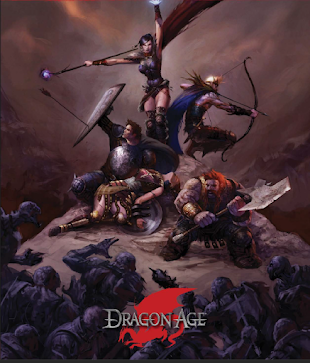Roleplaying on the Edge of your seat...
As we continue our look at other RPG systems, we will look at another system originally tied to a licensed IP. In this case we will be looking at the trio of interconnected Star Wars RPG’s; Edge of the Empire, Age of Rebellion, and Force and Destiny.
This article assumes some familiarity with the Star Wars IP, either canon or Legends content. For more information check out Wookieepedia.
Three games, One system
The Fantasy Flight Games (FFG) Star Wars games are an interesting approach to RPG design. We will discuss the actual mechanics in a bit, but first it's worth noting that this system is both one game, and three games.
What that statement means is that the underpinnings of each of the three product lines is the same. The mechanical rules of the game for combat, exploration, roleplaying encounters, etc. is fundamentally the same and always resolved the same regardless of which source book(s) you possess. The difference between the three product lines are the themes explored in each. These themes are commonly observed in other Star Wars media.
Edge of the Empire
As the name suggests, the first core rulebook to be released, Edge of the Empire (affiliate), was all about living life on the fringes of galactic society. Players would play rogues, scoundrels, smugglers and other rough and tumble characters, just trying to eke out a living. They may be escaped convicts on the run from the Empire, or mercenaries in the employ of a crime boss. They may be disorganized freedom fighters attempting to overthrow Zygyrian slavers, or smugglers, trying to get bacta, food, and weapons to their families in a remote Outer Rim colony.
Age of Rebellion
The second of the Core Rulebooks, Age of Rebellion (affiliate) tells the war stories of the Galactic Civil war. Player characters are rebel soldiers, pilots, engineers, and spies in the struggle against the oppressive Galactic Empire. They spend their time acquiring assets, freeing other captured rebels, and both leading assaults against, and repelling assaults from, Imperial forces.
Force and Destiny
The final core rulebook, Force and Destiny (affiliate), explores the themes of being a Force User. Primarily focused around the Jedi tradition, it also provides information regarding the Sith. The book contains a variety of force powers and allows for players to make characters who are Jedi in exile or young force sensitives coming to grips with their powers. It focuses on exploration and mastery of the force and the reclamation of lost knowledge.
Bringing It All Together
The core books, as presented above, were each their own product line. They had customized Game Master Screens, they had prewritten adventure modules tied to the themes and concepts of the version of the game being played, and they had a large collection of player facing source books that expanded character options for the different careers a player character could have. Full lists of the source books can be found on the Edge Studios website. On the surface, it would certainly seem that they were intended to be similar, but separate, games.
Anyone who has engaged with the Star Wars IP knows that this is rarely ever the case. The central themes in each of these RPG lines are always crashing into each other and overlapping in just about every story told in the Star Wars universe. It is inescapable.
That is true of these games as well.
The books were released in the order listed above, Edge of the Empire first followed by Age of Rebellion and then Force and Destiny last. In each book after the first, a section is provided on how to combine the themes of the different games and let players run characters from across the available spectrum of options. These sections also provided advice to the GM on how to tell stories that wove the games differing concepts into a cohesive story, and how to leverage the few specific mechanics tied to each game line in a more collaborative story.
The Setting
The obvious answer is that the games' setting is the Star Wars universe, but this doesn’t really tell the complete story. The Star Wars universe is vast, and across a trilogy of trilogies, covers many years, wars, and other political conflicts, some with drastic, world changing ramifications (Alderaan, the destruction of the Jedi, etc.). So the “setting” also has to include which “time period” in the Star Wars universe the three games are assumed to operate, though with a name like Age of Rebellion, it should be fairly obvious.
The three core games are generally designed to occur in the narrative space between Star Wars Episode IV: A New Hope and Star Wars Episode V: The Empire Strikes Back. The Death Star has been destroyed, but Luke Skywalker is not yet a Jedi and the Emperor still reigns supreme.
Period Pieces
After many product releases for the three core rule themes, FFG then began releasing product line agnostic books that provided setting context for other periods of time in the Star Wars Universe. Theses periods included Rise of the Separatists, exploring the early days of the Clone Wars, Collapse of the Republic, focusing on the end of the Clone Wars and the rise of the Galactic Empire, and finally Dawn of Rebellion, which examines the initial formation of the Rebellion in the time before the Battle of Yavin.
Additional Resources
These three settings books were also accompanied by three additional supplements to flesh out options in play. Those books were Gadgets and Gear, Starships and Speeders, and Allies and Adversaries. As can be surmised from the titles, each of these books detailed additional options, objects, vehicles and enemies for use in a Star Wars RPG campaign.
Let the Wookiee Win
The actual mechanics of the game are far more narrative focused than other TTRPGs. It is a dice pool game, where each time a character attempts anything that has a risk of failure, their player must assemble a pool of dice based on the characters natural abilities, trained skills, and situational modifiers. Each of the dice have a variety of symbols on them the count as success, failures, advantage, and threat.
Successes and failures cancel each other out one to one. Any roll needs only one uncancelled success to be considered as a successful roll, though additional successes can yield additional benefits based on the roll and situation. Advantage and Threat work similarly, as opposite effects, but provide more of a narrative flourish to the result of the dice roll beyond just binary success or failure.
It is possible to succeed on a roll, but have more threat generated than advantage. In an instance like this, perhaps the character manages to slice open the locked door, but alerts the guards on the floor above in the process. The opposite is true as well, that a character may fail the roll, but cause an unexpected opportunity or benefit to present itself. Perhaps a character fails an attack roll, but ends up with multiple advantage points, they may not have struck their target, but their missed shot accidentally blasted the door controls preventing any reinforcements from entering the room. Many of these options are left to the discretion of the Game Master, though others are options for players to choose, and most of the pre-written adventure modules typically detail potential options throughout the text.
Obviously, this is a gross simplification of the games ruleset, but this system (known as Genesys (affiliate) and available as a generic, setting neutral rule system) underpins the entire game, and is the main system players need to understand before diving into the rest of the games rules.
Most Unfortunate
Management of the Star Wars RPG which, had been very popular at its launch, was eventually transferred from FFG to Edge Studio after FFG was acquired by Asmodee. Releases and printings slowed and it is unfortunately quite difficult to find many of the books these days. Terms in the licensing of the game never permitted FFG to sell PDF’s of the books, so hard copies are still the only way one can play the game.
A few support PDF’s can still be found on the Edge Studios website for character and vehicle sheets, as well as base management sheets for those playing Age of Rebellion. Interestingly, there are also four free adventures that can be found on the FFG site. One adventure each as a follow-up to beginner game boxes that each product line had, and require that box to play fully, as well as a single one/two shot adventure in the Edge of the Empire product line which was a Free RPG Day release in 2013.
The End?
The short synopsis is that this a great game, extremely flavorful, and packed with fun narrative gameplay in one of the world’s biggest, most well known and beloved science fiction settings. For an entire generation of gamers, this was THE Star Wars RPG. Unfortunately, like with most properties bound to physical media, it has been increasingly more difficult to find, and thus more difficult for newer players to get started.
Despite this being the case, I felt like it was worth discussing today because it is a system I love, in a setting I love, and I just bet if you played it (and if you like Star Wars, which like….why wouldn’t you?) you would love it too. We just have to find some more books.
- The RPG Study
If you liked this article, please consider supporting The RPG Study with a coffee. Thanks!





Comments
Post a Comment